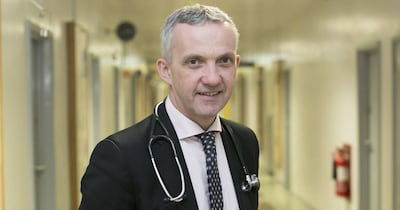Two decades ago the Republic was heading for the very much unwanted number one spot in Europe for the highest percentage of population living with obesity. But this trend has slowed and there are signs obesity rates may be reversing.
Preliminary findings from the second National Adult Nutrition Survey (Nans II) suggest that since 2011, there has been a reduction in obesity rates of 8 per cent among males (from 26 to 18 per cent) and 4 per cent in females (from 21 to 17 per cent). It also shows the prevalence of overweight has levelled off in both sexes.
The figures are still high. More than half of the representative sample of 1,000 adults aged 19 or over is classified as having overweight or obesity. This data is based on self-reported figures for height and weight, from which body mass index (BMI) is calculated. While BMI is used as a screening tool at population level, it takes an individual assessment to diagnose obesity – defined as abnormal or excessive body fat accumulation that presents a risk to health. However, Nans II is comparing like with like in highlighting trends from the first Nans of 2011.
“The tide is turning more rapidly than it ever has in terms of obesity management and awareness in Ireland,” says consultant endocrinologist Prof Donal O’Shea, who is the HSE’s national clinical lead for obesity. “Obviously, those of us who are in the middle of it would like it to turn even quicker.”
Currently, the World Health Organisation (WHO) ranks Ireland 11th in the EU for the incidence of obesity, but “we were third or fourth and heading for number one”, says O’Shea, in the run-up to World Obesity Day on Monday, March 3rd. “We were sleepwalking into obesity rates that I thought would be touching the United States”, where a third of the population is living with obesity.
But in recent years there have been a lot of positive moves and measures, he says. There is wider recognition, at last, that while there are programmes to treat all the complications of obesity, such as diabetes, heart disease, cancer and stroke, “if we prevent and treat the obesity, we will have less of all of those”. He singles out the contribution of the Irish Coalition of People Living with Obesity in bringing the patients’ voice to the policymakers. “It has had a massive impact.”
However, while there has been “solid progress” on the national clinical programme for obesity, he is concerned about the impact of the current recruitment embargo within the HSE. “It is 50 per cent funded and unless it is funded entirely, it is difficult for it to function efficiently,” he warns.

Greater investment in treatment services for obesity has resulted in a sharp drop in waiting times for bariatric surgery at St Colmcille’s Hospital in Loughlinstown, Dublin – one of only two such public centres in the country, the other being in Galway. There are plans for a new public bariatric surgical hub in Cork University Hospital and the first step towards that has been the appointment of a consultant to lead a public, weight management service in Mallow, Co Cork.
“This is a really exciting development,” says O’Shea. “We have been seeing people up in Loughlinstown from Cork and Kerry for the past 15 years. Now at last they will be able to be referred locally and have treatment up to and including surgery locally.”
There is wider awareness within the health service, he suggests, that prevention of obesity is different from treatment, and that for somebody living with what is a chronic condition, it’s not just a matter of “eat less, move more”.
“Not everybody gets it. We have orthopaedic surgeons routinely telling patients ‘I won’t do your knee until you lose weight. Go away and lose weight.’ We get that every week and it’s really disconcerting to still be hearing that.”
However, he believes development of drugs to treat obesity has been a “game-changer” in destigmatising the condition among health professionals who have been slower to recognise it as a disease. “Ozempic is very good for about one-third of people,” he says, and there are more effective drugs in the pipeline. These will need to be incorporated into the health system so there are, ultimately, fewer problems related to obesity.
As for actions outside the clinical arena, people underestimate just how effective the sugar sweetened drinks tax has been at a population level, he says. “With initiatives like that you begin to chip away at the issue.” The consumption of “soft” drinks has continued to increase but the total sugar consumed by those drinking them has decreased due to reformulation of the products.
“When you see the benefit of the sugar tax, I think you would want to look at widening tax on high fat, high salt, high sugar, highly processed foods [known as HFSS foods] and then invest the revenue from that. As soon as you tax those commodities the rate at which the food and drinks industry will reformulate will be astonishing.”
The economic incentive to manufacture products below the tax threshold means what people buy is healthier. “If you can influence the individual’s consumption by changing the environment, the individual isn’t even having to make the choice. The reformulation has delivered that.”

He is unhappy that calorie posting on menus has not yet been legislated for. “That is another simple, stupid piece that we know works,” he stresses. “But the food and drinks industry is still very good at their job of lobbying so it doesn’t happen.”
O’Shea’s colleague, Dr Cathy Breen, clinical specialist dietitian in the weight management service at Loughlinstown, says although there has been a significant reduction in waiting times for bariatric surgery, “there is still a bottleneck to get into the services”. People are prioritised on clinical need but the standard waiting time for a first appointment is still in the region of four years.
With funding approved for the start of a third weight management service in Cork, “things are moving on I suppose, to some degree”, says Breen, who is interim dietetic lead to the national obesity programme. The multidisciplinary team at Loughlinstown now sees about 24 new patients a month, both urgent cases and longer term waiters as they try to address the waiting list from both ends.
The criteria for surgery is BMI over 40, or over 35 with significant health complications. Although one of the best options for treating complex obesity, surgery is not a first-line intervention, she says. However, there is no longer the thinking that patients have to exhaust every other option in the programme before having a gastric sleeve or bypass procedure. “Now we try to assess the person where they are at. It is very, very rare that somebody comes to our services who hasn’t been through a long history of diet and activity and commercial programmes.”
The reduction in surgical waiting times to less than six months has been highly beneficial for the services as well as the patients, she says. When there used to be a three-year gap between being assessed for surgery and then reaching the top of the list, they effectively needed to be reassessed all over again. “That was really inefficient.”
Post surgery, there is a two-year programme of aftercare before they are discharged from the specialist services. But patients will be on long-term vitamins and have to change the way they eat. The long-term plan, she says, is to upskill people in primary care to support people in life after bariatric surgery.
Sarah O’Brien, national lead for the HSE’s Healthy Eating and Active Living Programme, is not getting carried away with any positive signs about the overweight/obesity rates. It remains to be seen, she says, if apparent improving trends are more than a “blip” and she would not like any sense of complacency to hit the impetus for tackling what is still a widespread health problem.
“We don’t have the public health infrastructure or evidence-based stuff that we know works in this area to sustain it.” There is a danger that “green shoots will be burnt by frost”.
One big concern is how disadvantaged groups in the population continue to be disproportionately impacted by the national rise in overweight and obesity over the past 30-plus years. This is reflected in the preliminary findings of Nans II, which is due to be published fully in June. Survey participants in the highest social class category have the lowest proportion of those living with obesity, at 14 per cent. Whereas rates among manual skilled and semi/unskilled are 30 per cent and 25 per cent respectively.
In terms of preventing our children and young people from developing obesity, we need to look at those wider factors that influence how we live. How our environment makes it harder to avail of healthier options
— Sarah O’Brien, national lead, Healthy Eating and Active Living Programme
“The unequal effects of the population level changes in weight status [BMI] mean that our children, young people and adults who already experience disadvantage are more likely to also live with poorer health for longer and die younger than their peers in more advantaged areas,” she says.
Population strategies, such as taxing unhealthy foods, create a more even benefit for everybody. There is plenty of evidence that voluntary codes don’t really work, she says. “They are really just a delaying tactic by sectors who don’t really want them. You only get the public health value and impact when they translate into actual regulations.”
Marketing and promotion of unhealthy foods and drinks also needs to be addressed, particularly digital marketing. Referring to regulator Coimisiún na Meán’s exclusion of HFSS foods from the definition of harmful audiovisual communications in its draft of an online safety code for video-sharing platform services, she warns that this approach would be “a lost opportunity to protect children’s health”.
There are things we can all do in our day-to-day lives to be healthier, “whatever our weight”, she adds, such as eating a healthy diet, being more active, having a good sleep routine and managing stress. “But in terms of preventing our children and young people from developing obesity, we need to look at those wider factors that influence how we live. How our environment makes it harder to avail of healthier options.”
- Sign up for push alerts and have the best news, analysis and comment delivered directly to your phone
- Find The Irish Times on WhatsApp and stay up to date
- Our In The News podcast is now published daily – Find the latest episode here





